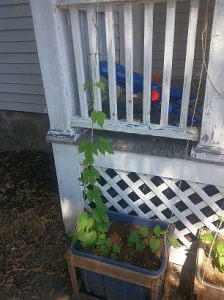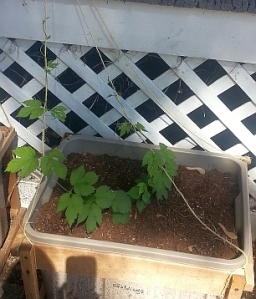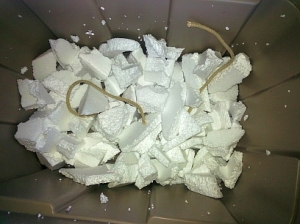I decided to get a little decadently rustic tonight . . . my first full day at home in weeks – and time to prep! Chocolate Stout Grain-Stuffed Cornish Game Hen on Brown Ale Rice Pudding with Carrots, Cranberries, and Mushrooms.
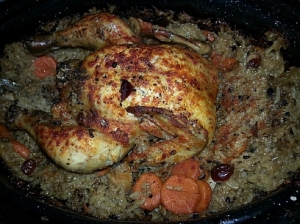
Roasted Game Hen on Ale Rice Pudding
Okay, so I did this at the beginning of June and never finished the post…just found the unfinished draft (thought it was up weeks ago!)…guess it’s time to finish it up!
As this was a bit of an experiment (and just serving myself), I stuck to a single bird. Start with thawing and unwrapping your Cornish game hen (really, just a small chicken). Rinse it thoroughly, inside and out. Check for giblets (not usually included in a game hen, but often held in plastic if they are there).
Soak the bird in a beer brine for 2-3hrs, tossing or rebasting regularly. Use 12-16oz brown ale, 2-4 Tbsp malt vinegar, and a few whole cloves and peppercorns with some bay leaves.
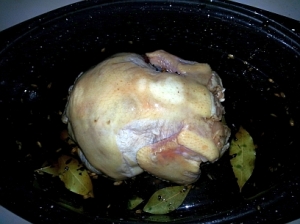
Brined Hen in Roast Pan
Season inside and out with salt and pepper (I also used some bay leaf, paprika and a small amount of granulated garlic and onion powder).
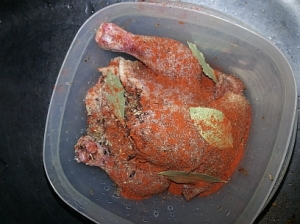
Seasoned Stuffed Game Hen
Pin or sew the neck opening shut, upend, and stuff with dried spent grains (I used grains from my Black Imp Quintipple Chocolate Stout). Pin opening shut (don’t sew this one just yet) and set aside to let rinse water and meat juices start soaking into the grain while the rest is prepped.

Game Hen Stuffed with Spent Grains
I used Basmati rice for this recipe, as it has a nice light, neutral flavor and does not get super-sticky…wild or long-grain domestic rice works quite well too (although more hard and will make more of a rice-side than a rice pudding texture). Try to avoid super-soft or super-sticky rices, like jasmine…also try to avoid strongly-flavoured ones, such as domestic brown rice (we’ll be adding more than enough flavor).
Measure your rice by pouring it dry into the bottom of your roast pan until 1/4″-3/8″ deep (which will end up coming close to halfway up the side of the bird, when all is said and done). Mix in some light seasoning, maybe 1-2 tsp. I used whole black peppercorns, a pinch of Herbes de Provence (a French blend of green herbs mixed with lavender), and a small amount of crushed coriander. Avoid adding salts to the rice at this point – salt will make the rice “skin up” in the hot liquid and make a harder rice than we want (some salt will come off of the bird, anyway). I also added 1 Tbsp of brown sugar. Mix the dry ingredients thoroughly.
Add in 1 can of sliced carrots, perhaps cut in half if large. I know, I know, canned carrots don’t taste nearly as good as fresh ones (and are missing most of the nutrients), but for soups and quick-bakes, I don’t have the patience to blanch/parboil them ahead. The canned ones give that nice carrot sweetness and a nice soft texture. This is primarily a soft-textured dish, so I really didn’t want anything too crunchy involved. Add 1 can sliced mushrooms or 1/2-3/4c sliced fresh mushrooms. Throw in a handful or two of dried cranberries for some bits of zip (again, if they are large, you may want to cut them down a bit). Mince up a fresh garlic clove or two and stir it all together thoroughly with 1-2 Tbsp heavy cream.

Adding Beer Brine
The first time I made this, I had placed the bird, poured the brine and more beer over it, then added the rice mix back in. While it worked, I tried it differently the next time and it worked much better. Unfortunately, I forgot to take a photo the second time around.
Push the rice mix into a mound in the center of the baking pan. Here’s the fun part. Hold your game hen neck-down over the mound and gently open the stuffing-flap. Slowly pour the beer brine into the ass end of the chicken so that is flows through the spent grains, drains out the neck hole, and pours down onto the center of the rice mound. This can take a few minutes, depending on how tightly you packed the grain and how sealed the neck hole is – the slower it goes (as long as it DOES go), the more flavour you will get from it.
When the dripping has (mostly) stopped, set the bird down and sew the buttflap shut. Push the rice mixture to the edges of the pan and nestle the bird into the center. Push the rice mix back down to form a fairly level layer all the way around the bird, covering the entire pan bottom that is not in contact with the chicken. The liquid level should be about halfway up to the level of the top of the rice. Remember that more liquid will drain from the bird and carrots, while some will be soaked up by the grain and cranberries. Accounting for this, add a little beer or water if you’re concerned it’s too dry (but remember that if it’s too wet, your rice will be a soggy mess…and if it’s too dry, it’ll burn).
Cover the pan and roast at 375*F for 45 minutes. Pull the pan out and uncover. Brush a little melted butter or olive oil over the bird. Sprinkle on a little smoked paprika or dark chili powder. Visually inspect the rice. If it looks like it needs it, lightly fluff with a fork (VERY lightly) and/or add a little water. (If it looks too wet, there’s not much you can do to fix it, so start thinking about another quick side dish.)
Return to oven uncovered for another 15 minutes (until skin is crisping, juices run clear, and the thickest part of the meat measures at least 165*F).
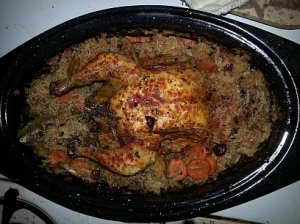
Game Hen Nicely Crisped
Remove from oven. Lift bird from the rice and set on large cutting board. Unpin/unsew neck and butt. Scrape out the spent grains and toss away (we want the flavours and scents, not the crunchies). Using large chef’s knife or cleaver, Cut bird in half down the breastbone and spine.

Game Hen Split with Grains Removed
With a large fork, lightly toss the rice mixture to break it up and separate it from the bottom (there will generally be a little burned down that you don’t want to mix in).
Place half game hen onto each plate. Spoon rice pudding on the side. Drizzle edges of plate with Sriracha. Accompany with a small dish of Pub Pickles. Serves 2.

Cornish Game Hen on Brown Ale Rice Pudding with Carrots, Cranberries, and Mushrooms
Complimentary Pairings: We need rich, malty ales to enhance earthy root vegetable notes – everything in this dish lives within +/- 8-10 inches of the soil line and we want our compliment to bring out the full, rich darkness of the soil itself and the warmth of the sunshine. I would serve with an English brown, Vienna/Märzen, Belgian dubbel, Roggenbier/Rauchbier, Scottish ale, or sweet/oatmeal/imperial stout to bring up the caramelly/melanoidin, chocolatey, and roasty/smoky notes, all of which have fairly low carbonation levels to allow the flavours of the beer and the dish to mingle freely. Be careful of going too far into the same flavour spectrum. An English mild, alt, or bock would just get lost next to the dish. A full-on Scotch ale would be sickeningly sweet and cloying after a few bites/sips. A dry stout or schwarzbier would seem sharp and acrid/astringent next to the umami-heavy flavours and oils in the dish.
Contrasting pairings: To contrast flavours, we need crisp, light ales/lagers to offset the dark, earthy notes with brightness and palate-scrubbing carbonation to reset the palate. I would serve with a not-too-hoppy pale ale, Kölsch, Berlinerweisse without syrup, or a Bohemian pilsner. A Belgian golden strong could be interesting, but the carbonation of a tripel would be more appropriate. A bready ESB or a malty Belgian singel or English pale ale would not have the right crispness to offset the flavour profile, but too much hoppiness could make for an unpleasant pairing.
Complex Pairings: This dish could be enhanced by pairing with: earthy funkiness to let the root veg flavours shine; enhancing spice, roast, or toffee to boost the seasonings; sweet/tart/sour notes to balance the very umami-heavy flavour profile; and some nice carbonation to reset the palate. I think any of the following pairings would give an attentive diner/imbiber plenty to ponder and experience: saison/biere de garde (enhancing spice, contrasting citrus, high carbonation), Flanders red (enhancing berry and oak, contrasting sour, low carb but acidity serves similar purpose resetting the palate), gueuze/lambic (earthy funk of course, sour/tart brightness, high carb+acid), barleywines/old ales (each is so uniquely complex….). The flavours of a dunkelweizen could certainly take the entire dish in a new direction. I think an oud bruin or weizenbock would run afoul of the same “getting lost” problem of the mild and alt to properly stand out.
Seasonal Pairings: This would make an excellent dish at any time of year, however, root vegetable flavours are most reminiscent of autumn and winter cooking. This would pair beautifully for Thanksgiving with any of the autumn seasonal beers such as harvest ales, pumpkin ales, and oktoberfests (avoid the fresh-hop IPAs/IPLs, though) and a side of cranberry sauce instead of the pickles. Christmas ales provide a rich, dark maltiness and loads of spices and preserved-fruit flavours, which would certainly suit a Christmas dinner (as would a Belgian dark ale). Likewise, later in the season, the maltiness and spices of winter ales would suit as wonderful pairings without the decadence of the fruits from the Christmas beers.
I hope you enjoy (I certainly did!)
Let me know what you think – if you give it a go yourself, send me tasting notes and a pic of how it came out!






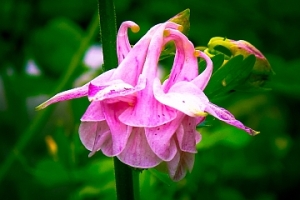


 After reading through the previous posts of the BJCP Update
After reading through the previous posts of the BJCP Update 









